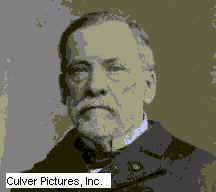Pasteurization Pasteurization , process of heating a liquid, particularly milk , to a temperature between 55 and 70 degrees C (131 and 158 degrees F), to destroy harmful bacteria without materially changing the composition, flavor, or nutritive value of the liquid. The process is named after the French chemist Louis Pasteur , who devised it in 1865 to inhibit fermentation of wine and milk. Milk is pasteurized by heating at a temperature of 63 degrees C (145 degrees F) for 30 minutes, rapidly cooling it, and then storing it at a temperature below 10 degrees C (50 degrees F). "Pasteurization," Microsoft Encarta 98 Encyclopedia 1993-1997 Microsoft Corporation. All rights reserved.
Louis Pasteur Louis Pasteur was a French chemist who lived between 1822-1895. He made great progress in the field of medicine when he came up with a theory about germs, tiny animals that can carry diseases. Pasteur later saved many lives when he developed vaccines for rabies and other deadly illnesses. Louis Pasteur made important contributions to the field of organic chemistry during the mid-1800s, developing various vaccines, including one for rabies, and disproving the theory of spontaneous generation. He is considered the founder of the field of microbiology, working with the germ theory of disease to establish and explain the causes for many diseases. Culver Pictures, Inc. "Louis Pasteur," Microsoft Encarta\'ae 98 Encyclopedia. 1993-1997 Microsoft Corporation. All rights reserved. Pasteur, Louis (1822-95), world-renowned French chemist and biologist, who founded the science of microbiology, proved the germ theory of disease, invented the process of pasteurization, and developed vaccines for several diseases, including rabies. Pasteur was born in Dole on December 27, 1822, the son of a tanner, and grew up in the small town of Arbois. In 1847 he earned a doctorate at the Ecole Normale in Paris, with a focus on both physics and chemistry. Becoming an assistant to one of his teachers, he began research that led to a significant discovery. He found that a beam of polarized light was rotated to either the right or the left as it passed through a pure solution of naturally produced organic nutrients, whereas when polarized light was passed through a solution of artificially synthesized organic nutrients, no rotation took place. If, however, bacteria or other microorganisms were placed in the latter solution, after a while it would also rotate light to the right or left. Pasteur concluded that organic molecules can exist in one of two forms, called isomers (that is, having the same structure and differing only in mirror images of each other), which he referred to as left-handed and right-handed forms. When chemists synthesize an organic compound, both of these forms are produced in equal proportions, canceling each other optical effects. Living systems, however, which have a high degree of chemical specificity, can discriminate between the two forms, metabolizing one and leaving the other untouched and free to rotate light. Work on Fermentation After spending several years of research and teaching at Dijon and Strasbourg, Pasteur moved in 1854 to the University of Lille, where he was named professor of chemistry and dean of the faculty of sciences. This faculty had been set up partly to serve as a means of applying science to the practical problems of the industries of the region, especially the manufacture of alcoholic beverages. Pasteur immediately devoted himself to research on the process of fermentation. Although his belief that yeast plays some kind of role in this process was not original, he was able to demonstrate, from his earlier work on chemical specificity, that the desired production of alcohol in fermentation is indeed due to yeast and that the undesired production of substances (such as lactic acid or acetic acid) that make wine sour is due to the presence of additional organisms such as bacteria. The souring of wine and beer had been a major economic problem in France; Pasteur contributed to solving the problem by showing that bacteria can be eliminated by heating the starting sugar solutions to a high temperature. Pasteur extended these studies to such other problems as the souring of milk, and he proposed a similar solution: heating the milk to a high temperature and pressure before bottling. This process is now called pasteurization. Contributed By: Randy Bird Garland E. Allen "Pasteur, Louis," Microsoft Encarta 98 Encyclopedia. 1993-1997 Microsoft Corporation. All rights reserved. (Vocabulary Words) Related Links The work of Louis Pasteur http://www.pasteur.fr/Pasteur/WLP.html The Pasteur Institute http://www.pasteur.fr/Pasteur/IP-uk.html Louis Pasteur The Germ Killer http://www.adventure.com/encyclopedia/general/rfipaste.html Louis Pasteur http://www.adventure.com/encyclopedia/general/ctspaste.html
|
